Meet the pilots of the Cape Fear River who navigate massive ships away from disaster
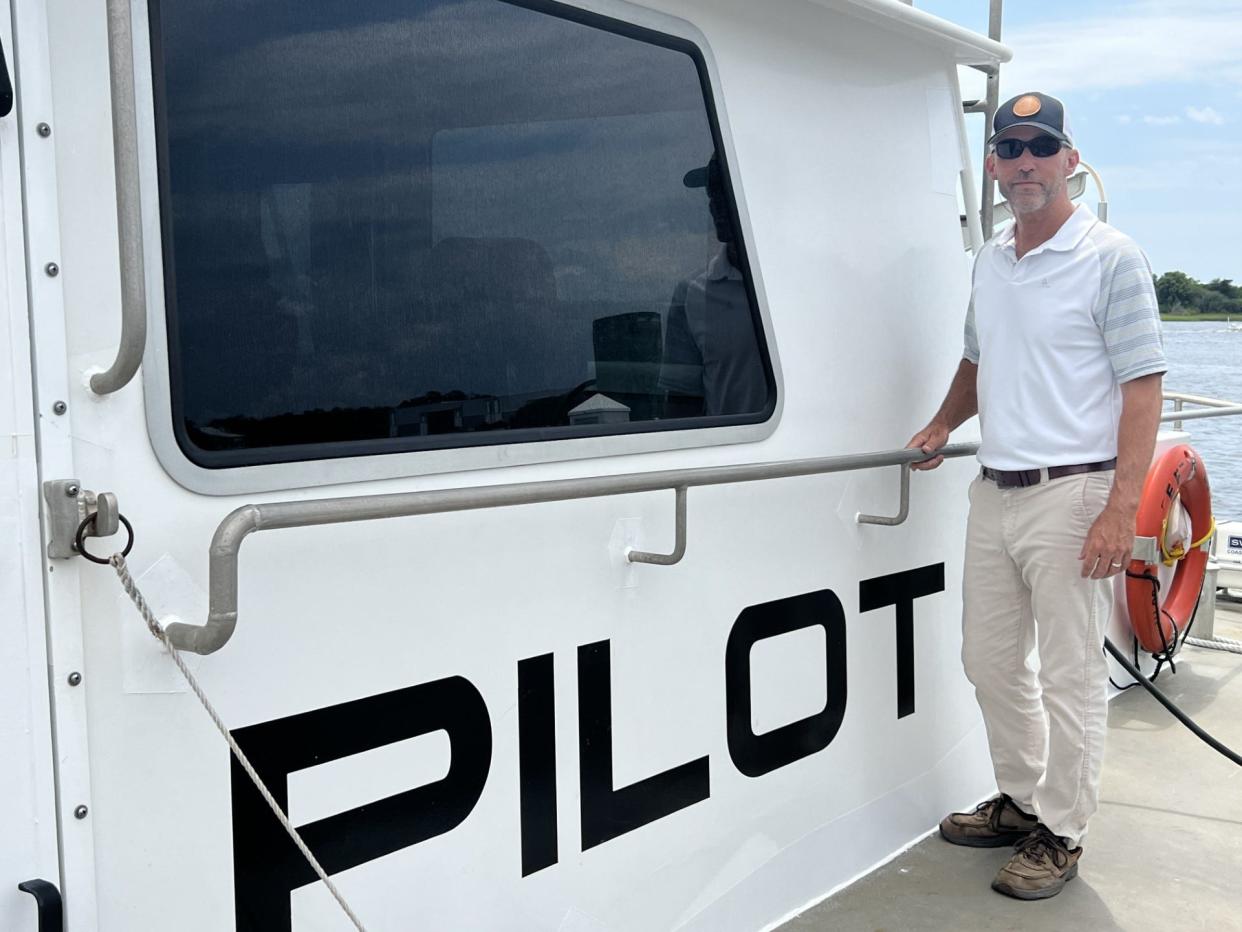
The sun shines overhead, and because it's still early, the heat and humidity haven't reached their usually unbearable July levels. It looks to be a day of good weather and calm seas, and Scott Aldridge is grateful as he approaches the sea buoy, seven miles off Oak Island.
As one of the Wilmington Cape Fear River Pilots, he’s preparing to climb aboard the San Americo, a liner service cargo ship anchored offshore. Once Aldridge boards, the ship will make its way to the Port of Wilmington.
“I think this one has a gangplank,” Aldridge says, grabbing his backpack.
“Yep, you can see it there on the side,” said Daniel Dixon, a longtime Cape Fear Pilots Association employee, gesturing toward the metal ramp suspended on the side of the ship.
Dixon steers the boat up to where its rails are touching the nearly 650-foot-long ship. Aldridge heads out the door and onto the bow with an apprentice pilot following behind as a spotter. Members of the ship’s crew are gathered on the deck, looking at the pilot boat several stories below.
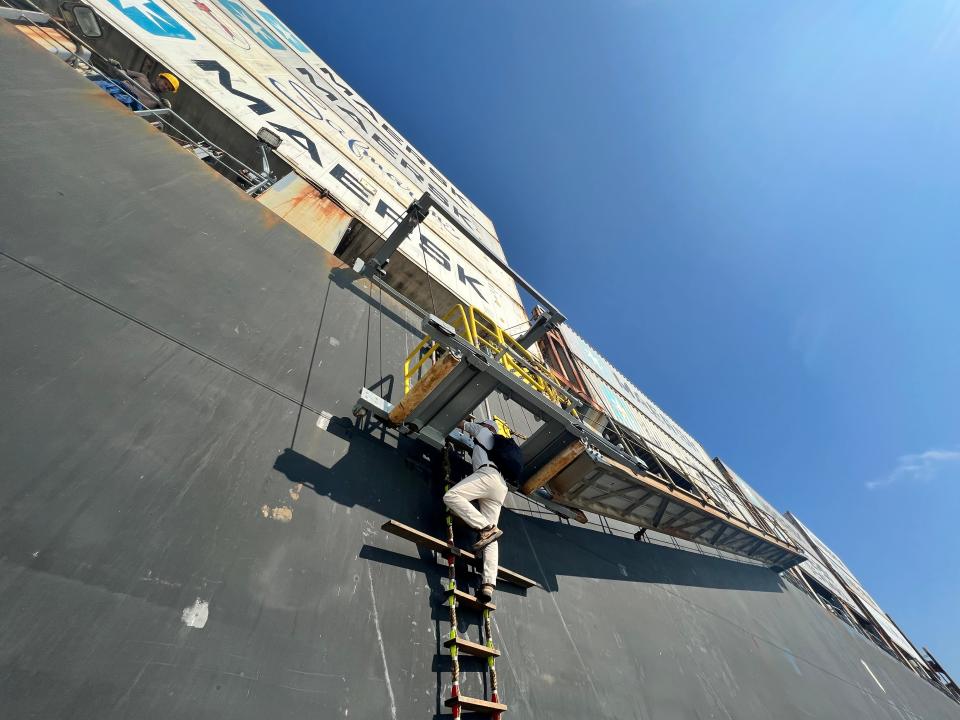
Aldridge makes a little jump, grabs a rope ladder and climbs rapidly until he reaches the metal gangplank. Wearing his backpack, he hoists himself onto the gangplank and safely boards the ship.
About forty-five minutes later, the San Americo pulls into the Cape Fear River and people gather around the waterfront to watch it pass by. While passing ships make for beautiful pictures, few realize the work that goes on behind the scenes.
For more than 100 years, the Wilmington Cape Fear Pilots Association has guided ships around the river’s shoals and safely to port. While many in the area aspire to be river pilots, positions are limited. The few who achieve it will tell you it takes the right combination of knowledge, skill, and good timing.
From the ‘Wild West’ to a regulated industry
River pilots have been bringing ships into the area for hundreds of years, but the job wasn’t always the civilized, professional industry it is today. In the late 1800s and early 1900s, it was a fight — literally.
“It was the Wild West,” Aldridge recalled.
According to the lore, pilots in those days were tough gun-toting characters who would lie in wait for a ship to arrive and fight to be the one who took it upriver.
As a result, the State of North Carolina stepped in and created the Cape Fear River Navigation and Pilotage Commission to regulate the industry. The commission is comprised of five members with four appointed by the governor: three from New Hanover County and one from Brunswick County. The president of the Wilmington Cape Fear Pilots Association serves as the fifth member of the commission.
In addition to establishing the rules and regulations, the commission also sets pilotage rates and outlines an apprenticeship program for incoming pilots. While the Association interviews and recommends candidates for apprenticeship, the Commission has the final say in which applicants are appointed.
Currently, there are eight pilots in the Association — a number set by statute — and the turnover rate is low, leaving few vacancies for newcomers.
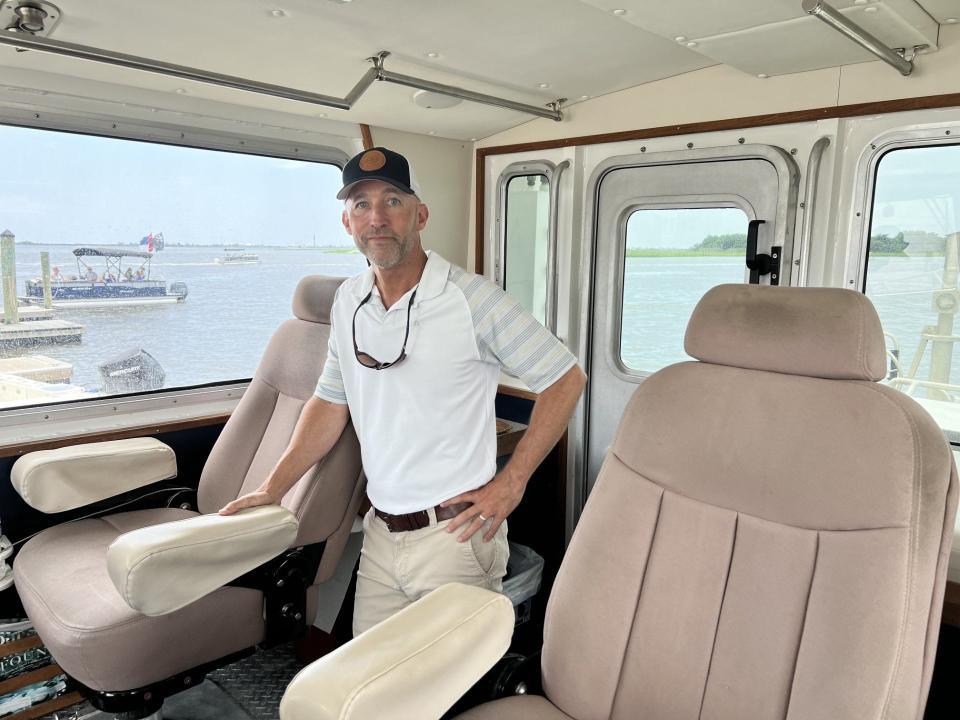
A ‘pipe dream’ to reality
Aldridge was about eight years old when he set his sights on being a river pilot. While out on the boat with his family, they encountered a cargo ship in the river. Aldridge’s dad explained that it was Davey Herring, one of their neighbors, piloting the ship.
“I was mesmerized,” Aldridge said. “I was like, ‘Wait a minute now…somebody I know is on board and driving that ship?’ That was the coolest thing I could imagine — driving something that big.”
That was when Aldridge set his course to become a river pilot. He admits he didn’t know if it was a goal he could ever achieve. Even if a candidate meets the requirements, there also must be an anticipated opening.
“It was certainly a goal, but it was also a pipe dream,” he explained. “It’s obviously something that’s very difficult to get in to since the association’s turnover rate is low. I was blessed with good timing.”
Before Aldridge graduated from East Carolina University, the state passed a new law requiring river pilots to have either a four-year degree or hold an ocean-going maritime license. He was working on a tugboat at Military Ocean Terminal Sunny Point when he learned of an upcoming vacancy and applied.
His education, local knowledge of the river, and job experience clinched him an apprentice spot, and this will be his 30th year with the Wilmington Cape Fear Pilots Association.
During that time, Aldridge has had the opportunity to bring in ships from all over the world, and each time he steps aboard, he enters a diverse environment where many cultures and nationalities are represented. He said the crew members are always welcoming, offering something to drink, sharing meals, and ensuring he’s comfortable.
“They are, to me, some of the nicest, most accommodating, pleasant people to be around,” he said. “They are hardworking, and they are gone from their home for months and months — sometimes years, at a time. I feel like I am going on their home when I go aboard, and I treat it that way. We all do.”
While bringing in ships from all over the world is just another day on the job, the pilots especially enjoy the days when they get to do something a little different. For Aldridge, one of those including piloting the U.S.S. North Carolina, a Virginia-class attack submarine, upriver for its commissioning.
More on the Port: Years after big plans for Brunswick land were scrapped, here's the latest on the property
Boarding the sub proved difficult due to the weather, and it was difficult to get the pilot boat into position without running over the sub. After failing to board using a gangplank, Aldridge decided to do something crazy.
“I don’t know why to this day, but I had them come alongside, and I jumped,” he recalled. “There were two frogmen sitting there in wetsuits, masks, snorkels, and fins, and they basically caught me. But when you’re jumping, you’re going onto a rounded can.”
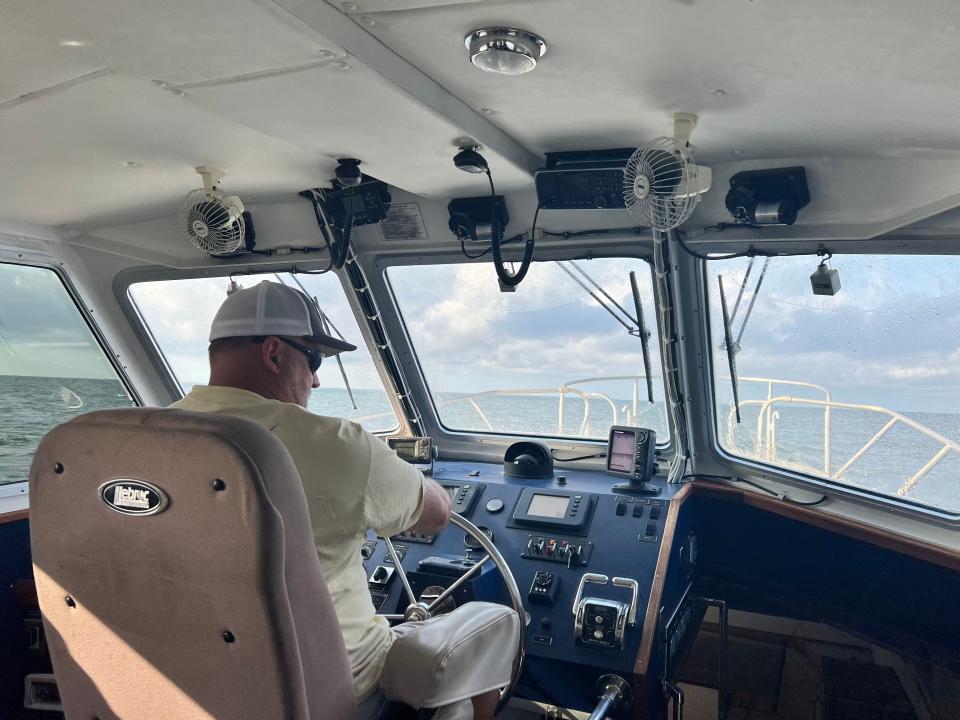
When Aldridge finally boarded the sub, he was shaking and couldn’t believe what he’d just done. He added it’s not something he would do these days. Despite the difficult time getting aboard, he enjoyed a tour of the sub and was joking around with the crew. The only concern was making the turn near Battery Island.
“Just before we get to the turn, the captain said, ‘Mr. Pilot, please do not forget that you have $2.3 billion worth of U.S. territory underneath your feet. Don’t run aground,’” Aldridge recalled.
The trip was a success. Other memorable experiences include piloting a ship during the no-name hurricane of March of 1993 and bringing in the Panamax cranes a few years ago.
The industry has seen some changes during his time, and Aldridge has enjoyed having a front row seat. He reflected on the transition to the “ultra-large container ships” that are 1,100 and 1,200 feet long.
“It’s something that we wouldn’t have thought possible less than five years ago,” he said. “And the state really stepped in and made changes to the river and their pier-side facilities, including the new cranes, widening the turn basin, and raising the power lines. I would have never thought in my career that we would get a ship that size in this river.”
Aldridge still has a few years left before his retirement, and now, he’s focused on helping the new pilots navigate the industry.
The next generation
Brent Gainey, a Carolina Beach native, also had a childhood dream of becoming a river pilot. As someone who grew up in the marine industry, he knew the local waters. During college, Gainey obtained his captain’s license and worked in charter fishing with the hope of becoming an apprentice pilot. But the timing wasn’t right, so he accepted a position with O.E. DuRant, a ship chandler and line boat company in Wilmington.
“We were supplying the ships with anything they needed while they were in Port,” he said.
Gainey also ran a small tugboat tying up the ships at the tanker terminals.
“I was working with the pilots, working with the tugboats, working with everybody,” he said.
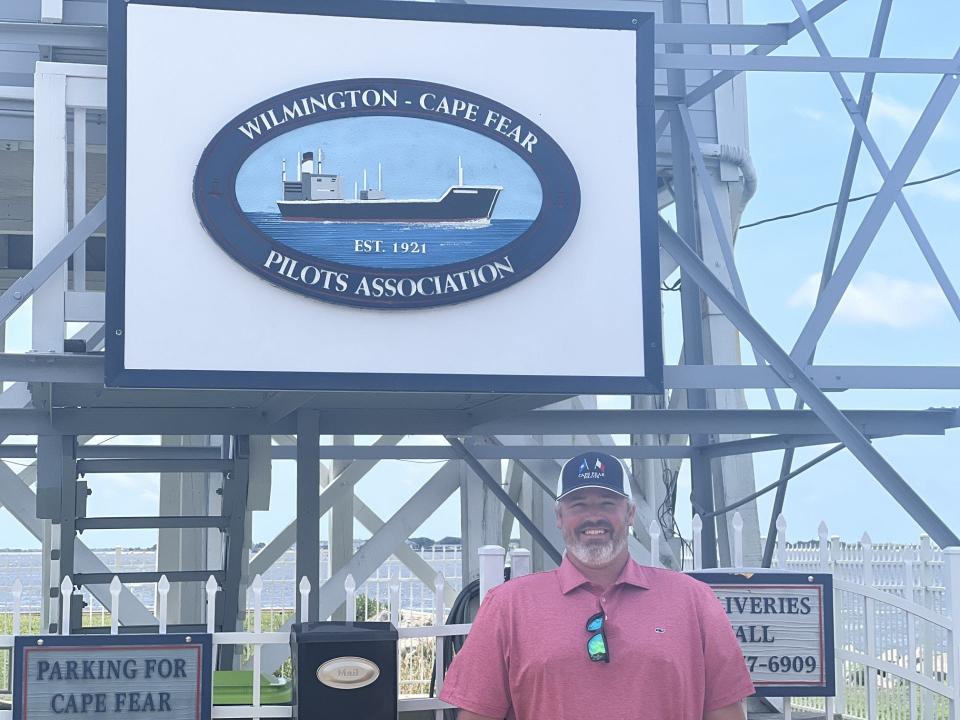
Gainey had worked for O.E. DuRant for about 10 years when he finally heard the Association would be taking on another apprentice.
“I got lucky, got voted in, and here we are now a little over four years later,” he said, sitting in the Cape Fear Pilots’ Tower in Southport.
Gainey explained the apprenticeship was a four-year program, with the first three years focused on obtaining a Federal Pilots’ License. Under this license, Pilots can take American vessels up the river to Port. However, North Carolina requires a state license to take foreign vessels upriver, and that is earned at the completion of the fourth year of the apprenticeship.
Gainey obtained his full state pilots’ license on July 13, making him a full partner in the Association. He said while he’s grateful to have achieved his goal, he has yet to absorb it.
“It is exciting to know I’m here, I accomplished what I set out to do, and now, I get to look forward to the next 25 years of being right here up and down the river with these other pilots,” he said.
STAY CONNECTED: Keep up with the area’s latest Brunswick County news by signing up for the Brunswick Today newsletter and following us on Facebook and Instagram.
This article originally appeared on Wilmington StarNews: Wilmington Cape Fear Pilots guiding ships to safety

